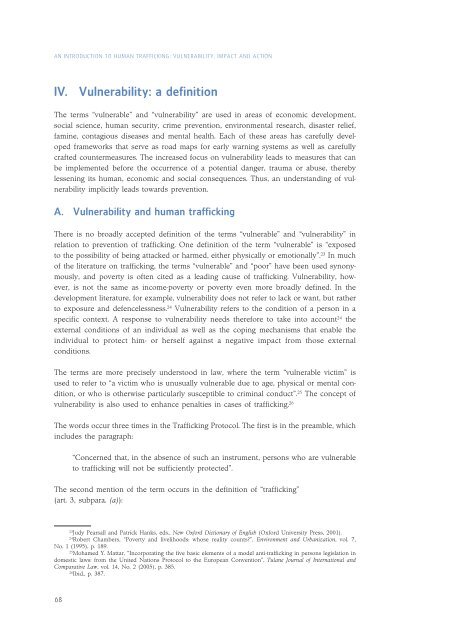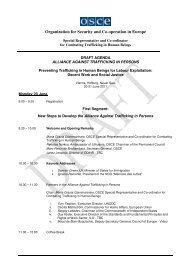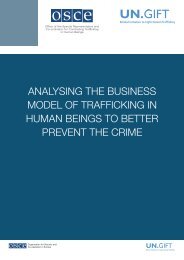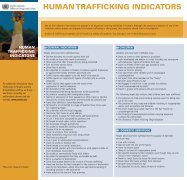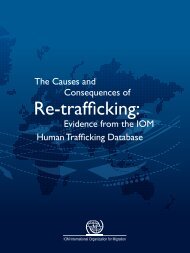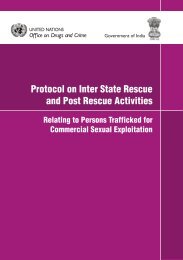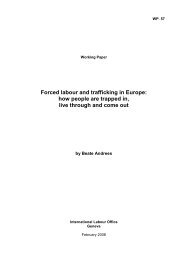An Introduction to Human Trafficking - United Nations Office on ...
An Introduction to Human Trafficking - United Nations Office on ...
An Introduction to Human Trafficking - United Nations Office on ...
Create successful ePaper yourself
Turn your PDF publications into a flip-book with our unique Google optimized e-Paper software.
AN INTRODUCTION TO HUMAN TRAFFICKING: VULNERABILITY, IMPACT AND ACTION<br />
IV.—Vulnerability: a definiti<strong>on</strong><br />
The terms “vulnerable” and “vulnerability” are used in areas of ec<strong>on</strong>omic development,<br />
social science, human security, crime preventi<strong>on</strong>, envir<strong>on</strong>mental research, disaster relief,<br />
famine, c<strong>on</strong>tagious diseases and mental health. Each of these areas has carefully developed<br />
frameworks that serve as road maps for early warning systems as well as carefully<br />
crafted countermeasures. The increased focus <strong>on</strong> vulnerability leads <str<strong>on</strong>g>to</str<strong>on</strong>g> measures that can<br />
be implemented before the occurrence of a potential danger, trauma or abuse, thereby<br />
lessening its human, ec<strong>on</strong>omic and social c<strong>on</strong>sequences. Thus, an understanding of vulnerability<br />
implicitly leads <str<strong>on</strong>g>to</str<strong>on</strong>g>wards preventi<strong>on</strong>.<br />
A.—Vulnerability and human trafficking<br />
There is no broadly accepted definiti<strong>on</strong> of the terms “vulnerable” and “vulnerability” in<br />
relati<strong>on</strong> <str<strong>on</strong>g>to</str<strong>on</strong>g> preventi<strong>on</strong> of trafficking. One definiti<strong>on</strong> of the term “vulnerable” is “exposed<br />
<str<strong>on</strong>g>to</str<strong>on</strong>g> the possibility of being attacked or harmed, either physically or emoti<strong>on</strong>ally”. 23 In much<br />
of the literature <strong>on</strong> trafficking, the terms “vulnerable” and “poor” have been used syn<strong>on</strong>ymously,<br />
and poverty is often cited as a leading cause of trafficking. Vulnerability, however,<br />
is not the same as income-poverty or poverty even more broadly defined. In the<br />
development literature, for example, vulnerability does not refer <str<strong>on</strong>g>to</str<strong>on</strong>g> lack or want, but rather<br />
<str<strong>on</strong>g>to</str<strong>on</strong>g> exposure and defencelessness. 24 Vulnerability refers <str<strong>on</strong>g>to</str<strong>on</strong>g> the c<strong>on</strong>diti<strong>on</strong> of a pers<strong>on</strong> in a<br />
specific c<strong>on</strong>text. A resp<strong>on</strong>se <str<strong>on</strong>g>to</str<strong>on</strong>g> vulnerability needs therefore <str<strong>on</strong>g>to</str<strong>on</strong>g> take in<str<strong>on</strong>g>to</str<strong>on</strong>g> account 24 the<br />
external c<strong>on</strong>diti<strong>on</strong>s of an individual as well as the coping mechanisms that enable the<br />
individual <str<strong>on</strong>g>to</str<strong>on</strong>g> protect him- or herself against a negative impact from those external<br />
c<strong>on</strong>diti<strong>on</strong>s.<br />
The terms are more precisely unders<str<strong>on</strong>g>to</str<strong>on</strong>g>od in law, where the term “vulnerable victim” is<br />
used <str<strong>on</strong>g>to</str<strong>on</strong>g> refer <str<strong>on</strong>g>to</str<strong>on</strong>g> “a victim who is unusually vulnerable due <str<strong>on</strong>g>to</str<strong>on</strong>g> age, physical or mental c<strong>on</strong>diti<strong>on</strong>,<br />
or who is otherwise particularly susceptible <str<strong>on</strong>g>to</str<strong>on</strong>g> criminal c<strong>on</strong>duct”. 25 The c<strong>on</strong>cept of<br />
vulnerability is also used <str<strong>on</strong>g>to</str<strong>on</strong>g> enhance penalties in cases of trafficking. 26<br />
The words occur three times in the <str<strong>on</strong>g>Trafficking</str<strong>on</strong>g> Pro<str<strong>on</strong>g>to</str<strong>on</strong>g>col. The first is in the preamble, which<br />
includes the paragraph:<br />
“C<strong>on</strong>cerned that, in the absence of such an instrument, pers<strong>on</strong>s who are vulnerable<br />
<str<strong>on</strong>g>to</str<strong>on</strong>g> trafficking will not be sufficiently protected”.<br />
The sec<strong>on</strong>d menti<strong>on</strong> of the term occurs in the definiti<strong>on</strong> of “trafficking”<br />
(art. 3, subpara. (a)):<br />
23<br />
Judy Pearsall and Patrick Hanks, eds., New Oxford Dicti<strong>on</strong>ary of English (Oxford University Press, 2001).<br />
24<br />
Robert Chambers, “Poverty and livelihoods: whose reality counts?”, Envir<strong>on</strong>ment and Urbanizati<strong>on</strong>, vol. 7,<br />
No. 1 (1995), p. 189.<br />
25<br />
Mohamed Y. Mattar, “Incorporating the five basic elements of a model anti-trafficking in pers<strong>on</strong>s legislati<strong>on</strong> in<br />
domestic laws: from the <str<strong>on</strong>g>United</str<strong>on</strong>g> <str<strong>on</strong>g>Nati<strong>on</strong>s</str<strong>on</strong>g> Pro<str<strong>on</strong>g>to</str<strong>on</strong>g>col <str<strong>on</strong>g>to</str<strong>on</strong>g> the European C<strong>on</strong>venti<strong>on</strong>”, Tulane Journal of Internati<strong>on</strong>al and<br />
Comparative Law, vol. 14, No. 2 (2005), p. 385.<br />
26<br />
Ibid., p. 387.<br />
68


